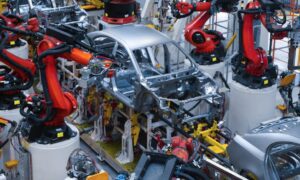Introduction
In the vast expanse of technological innovation and scientific advancement, aerospace engineering stands as a beacon of human achievement. As we look towards the skies, marveling at the flight of sophisticated aircraft and spacecraft, it’s crucial to understand the unsung heroes behind these marvels: aerospace engineers. In this comprehensive exploration, we will delve into the world of aerospace engineering, unraveling the intricacies of this fascinating field that pushes the boundaries of human imagination and exploration.
Defining Aerospace Engineering
Aerospace engineering is a specialized branch of engineering that encompasses the design, development, testing, and production of aircraft, spacecraft, and related systems. It is a multidisciplinary field that combines elements of mechanical engineering, electrical engineering, computer science, and physics to create vehicles capable of defying gravity and exploring the vast expanses beyond our atmosphere.
The Evolution of Aerospace Engineering
The roots of aerospace engineering can be traced back to the early 20th century, when pioneers like the Wright brothers revolutionized transportation with the invention of the first successful powered aircraft. As the world entered the era of aviation, the demand for skilled engineers to design and improve aircraft soared. With the onset of the Space Age in the mid-20th century, aerospace engineering took a giant leap forward, expanding its scope to include the design and development of spacecraft for human and robotic exploration beyond Earth.
Key Areas of Aerospace Engineering
Aerospace engineering encompasses a wide range of sub-disciplines, each focusing on specific aspects of flight and space exploration. The key areas include:
1. Aerodynamics:
Aerodynamics is the study of the behavior of air as it interacts with solid objects, such as aircraft and spacecraft. Aerospace engineers specializing in aerodynamics design wings, control surfaces, and propulsion systems to optimize the performance and efficiency of vehicles.
2. Structures and Materials:
This aspect of aerospace engineering deals with the design and construction of the physical framework of aircraft and spacecraft. Engineers in this field work with advanced materials to ensure the structural integrity and durability of vehicles that operate in extreme conditions.
3. Propulsion:
Propulsion engineers focus on the development of engines and propulsion systems that enable aircraft and spacecraft to generate thrust. This includes traditional jet engines, rocket propulsion, and emerging technologies like ion drives for space exploration.
4. Avionics and Control Systems:
Avionics refers to the electronic systems on board aircraft and spacecraft. Aerospace engineers specializing in avionics design navigation systems, communication systems, and control systems that govern the flight or trajectory of vehicles.
5. Systems Engineering:
Systems engineers take a holistic approach, overseeing the integration of various components and subsystems to ensure that the entire aerospace system functions seamlessly. They play a crucial role in managing the complex interactions between different elements of an aircraft or spacecraft.
Educational Journeys of Aerospace Engineers
Becoming an aerospace engineer requires a solid educational foundation and a passion for pushing the boundaries of technology. The typical educational journey includes:
1. Bachelor’s Degree:
Aspiring aerospace engineers usually start with a bachelor’s degree in aerospace engineering or a related field, such as mechanical engineering. The curriculum covers the fundamental principles of physics, mathematics, and engineering, providing a broad understanding of the field.
2. Internships and co-ops:
Many aerospace engineering programs encourage students to gain practical experience through internships or cooperative education programs with aerospace companies. This hands-on experience is invaluable for developing real-world skills and networking within the industry.
3. Master’s or Ph.D. (optional):
While a bachelor’s degree is often sufficient for entry-level positions, some engineers pursue advanced degrees, especially if they are interested in research, academia, or highly specialized roles. A master’s or Ph.D. in aerospace engineering allows for deeper exploration of specific topics within the field.
Skills and Qualities of Aerospace Engineers
Aerospace engineers possess a unique set of skills and qualities that are essential for success in this demanding field.
1. Analytical Skills:
Aerospace engineers must analyze complex problems and develop innovative solutions. Strong analytical skills are crucial for understanding the intricate interactions between various components of aerospace systems.
2. Attention to detail:
Precision is paramount in aerospace engineering. Engineers must pay meticulous attention to detail during the design, testing, and production phases to ensure the safety and reliability of aerospace vehicles.
3. Creativity:
Innovation is at the heart of aerospace engineering. Creative thinking is essential for designing cutting-edge technologies and overcoming challenges in the pursuit of more efficient and advanced aerospace systems.
4. Teamwork and Communication:
Aerospace projects are typically collaborative efforts involving diverse teams of engineers, scientists, and professionals. Effective communication and teamwork skills are vital for successful project execution.
5. Adaptability:
Aerospace engineering is a dynamic field that constantly evolves with advancements in technology. Engineers must be adaptable, staying abreast of emerging technologies and adjusting their approaches to meet evolving industry standards.
Challenges and Innovations in Aerospace Engineering
As aerospace engineers push the boundaries of what is possible, they face numerous challenges that drive innovation. Some of the current challenges include:
1. Sustainability:
As concerns about environmental impact grow, aerospace engineers are exploring sustainable aviation solutions, including electric and hybrid propulsion systems, to reduce the carbon footprint of air travel.
2. Space Exploration:
The quest for exploration beyond Earth continues to drive advancements in aerospace engineering. Engineers are working on developing new propulsion systems, life support technologies, and materials for long-duration space missions.
3. Autonomous Systems:
The integration of autonomous technologies is transforming aerospace systems. Engineers are developing unmanned aerial vehicles (UAVs) and autonomous spacecraft that can perform complex tasks without direct human intervention.
4. Supersonic and hypersonic flight:
Engineers are actively researching and developing supersonic and hypersonic aircraft that could revolutionize air travel by drastically reducing travel times. However, these high-speed vehicles pose unique engineering challenges.
Conclusion
Aerospace engineering is a captivating and dynamic field that fuels humanity’s desire to explore the skies and beyond. Aerospace engineers play a pivotal role in shaping the future of air and space travel, overcoming challenges, and driving innovation. From the early days of aviation to the frontiers of space exploration, these professionals continue to push the boundaries of what is technologically achievable, leaving an indelible mark on the history of human achievement. As we marvel at the wonders of flight and space exploration, let us appreciate the brilliance and dedication of the individuals who make it all possible—the aerospace engineers.



































